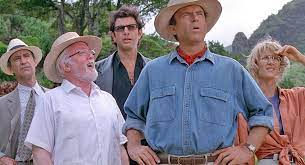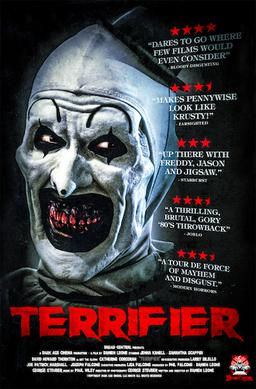Jurassic Park (1993) review
- Jeremy Kelly
- Jun 8, 2022
- 5 min read
Jurassic Park (1993)
Directed by: Steven Spielberg
Produced by: Kathleen Kennedy, Gerald R. Molen
Screenplay by: Michael Crichton, David Koepp
Starring: Sam Neill, Laura Dern, Jeff Goldblum, Richard Attenborough, Bob Peck, Martin Ferrero, Samuel L. Jackson, Wayne Knight

Every once in a long while, a film comes along that completely changes the entire special effects game. You think about the original “King Kong” and all the new techniques it pioneered, “Jason and the Argonauts” and the various stop-motion creatures that Ray Harryhausen invented, or “Mary Poppins” and its new blending of live action and animation. But in the early 1990s, there were two films that pushed the boundaries again, showcasing how far computer generated imagery (CGI) could be taken in filmmaking; the first was “Terminator 2: Judgment Day,” and the second was “Jurassic Park.” Based on the Michael Crichton novel about a theme park featuring living dinosaurs that run amok, this blew away critics and movie-goers alike, becoming a landmark in filmmaker Steven Spielberg’s illustrious career and inspiring future action and science fiction endeavors. With the new “Jurassic World” installment coming out this weekend, I wanted to take a look back at the original classic, and discuss how its awesome aesthetics and likeable characters still hold up almost 30 years later.
In the waters near Costa Rica, the tropical Isla Nublar hosts a park of dinosaurs, created by Scottish industrialist John Hammond (Richard Attenborough). Currently dealing with various safety concerns, Hammond invites paleontologist Alan Grant (Sam Neill), paleobotanist Ellie Sattler (Laura Dern), mathematician Ian Malcolm (Jeff Goldblum), and lawyer Donald Gennaro (Martin Ferrero)—who represents the park’s investors—to properly survey the park in a preliminary stage before it can open to the public. They’re all understandably amazed by the sight and spectacle, created via combination of genetic engineering and cloning. However, the park’s lead computer programmer Dennis Nedry (Wayne Knight) steals a pack of dinosaur embryos, intending to sell them to a rival of Hammond’s and deactivating the security system in the process. Unfortunately, this happens during the middle of the tour, with a hurricane on the way. So now it’s dark and stormy, and the dinosaurs are breaking out of their cages, with the characters—including Hammond’s grandchildren Lex (Ariana Richards) and Tim (Joseph Mazzello), paired with Grant, who isn’t good with kids—right in the middle of it.

The advent of big-scale CGI has made numerous practical filmmaking methods something of a lost art, so it’s notable when a movie uses it to enhance the visual experience, but not as an all-encompassing substitute. When Spielberg signed on to direct this, his idea was to make the dinosaurs entirely mechanical, but surmised that it would be too expensive and unconvincing. However, he still had the wherewithal to consult with some of the great visual artists in the industry to make the look as authentic as possible: effects kingpin Stan Winston, animator Phil Tippett, supervisor Michael Lantieri, and Dennis Muren, a mainstay at Industrial Light & Magic, the visual effects studio founded by George Lucas. So they didn’t just dabble on computers and call it a day—apologies for over-simplification in the interest of time—but basically featured the best of different ideas. Many of the long shots were CGI, but the Triceratops, Dilophosaurus, and Tyrannosaurus Rex all appeared as life-size animatronics, and the computerized movements were simulated as stop-motion. The result is an unbelievable display of creativity and passion that ranges from big and majestic to intimate and terrifying, with the T-rex attacking the jeeps the most show-stopping example.
There isn’t much I can say about the characters; they’re not particularly deep, but you believe them in their respective situations, and they connect in ways that are easy enough to latch onto. Sam Neill and Laura Dern have good chemistry as Grant and Sattler; he’s gruff and grounded, and she’s sassy and confident. We enjoy watching them collaborate and be so invested in their work; and because it’s Dern, she’s going to have extremely expressive and unique facial reactions. This is also one of the first films the world became introduced to Jeff Goldblum, who by now has almost become a parody of himself, but is still just so darn entertaining as this droll, off-beat, unusual Malcolm, who frequently spouts about chaos theory and how “life…finds a way.” In the novel, Malcolm actually dies at the end, but here he survives, and the character became so popular that when the sequel novel “The Lost World” came out, he was written back to life. Meanwhile, Richard Attenborough is endearing as the enthusiastic and ultimately foolish Hammond, Samuel L. Jackson gets some prominent scenes as the park’s chief engineer Ray Arnold, and the kids—though somewhat underwritten—make for decent enough characters and not just helpless MacGuffins.

Now while the film definitely captures the wonder and survival aspect especially well—the suspense is particularly outstanding when the T-rex and velociraptors come out to play—there are a lot of corny and cliché elements as well. While there are intelligent conversations about how far science should go and nature ultimately taking over, the exposition is rushed, and the dialogue gets pretty cheesy, which I think is just an unfortunate ingrained flaw of David Koepp as a screenwriter. There are numerous storylines that don’t really go anywhere, like the people Nedry tries to sell the embryos to, various contingencies on how to stop a dinosaur outbreak, the sick Triceratops, and just these kind of random trains of thought characters will come up with. Also, for as much as we root for these people, they make some really dumb decisions, like go off on their own and not think to lock the doors behind them. But that’s kind of par for the course with movies like this, and the surplus of memorable chase sequences and set pieces more than makes up for it.
When it comes down to it, the whole film is just a visual and audio masterpiece; I didn’t even mention John Williams’s musical score that really sells how huge and magnificent this all is, as well as the beautiful Hawaiian scenery and landscapes that really make this place look alive. Unsurprisingly, “Jurassic Park” won Oscars for Best Sound Editing, Sound Mixing, and Visual Effects, and it became the highest grossing film worldwide, but its cultural impact has lasted far beyond the box office and winning a couple trophies. Public youth interest in paleontology reportedly skyrocketed, and it convinced other filmmakers that they could create things on the screen they once thought impossible; Lucas, Stanley Kubrick and Peter Jackson would all be inspired to new big projects. I really think Spielberg is at his best with films like these, taking B-movie plots and injecting it with the craft and scale of a major Hollywood production. “Jaws” is basically a 1950s monster movie, “E.T.” is an innocent throwback about aliens coming to Earth, and “Indiana Jones” is a tribute to old action adventure serials. This is a film about dinosaurs attacking, yet it’s become one of the most groundbreaking ever made; there have now been several sequels, with one about to come out, and though they’re all enjoyable in one way or another, none on the level of ingenuity as the original, which is flawed but overall pretty spectacular.
My rating: 9/10





Comments